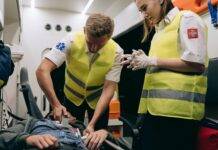
Trauma Care: A Comprehensive Guide to Providing Effective Emergency Medical Treatment
Accidents and unexpected incidents can happen at any time, often resulting in traumatic injuries that require immediate medical attention. Trauma care plays a pivotal role in saving lives and minimizing the long-term impact of injuries. In this article, we will delve into the world of trauma care, exploring its importance, the key components of effective trauma care, and how it can make a significant difference in critical situations.
Introduction to Trauma Care
Trauma care is a specialized branch of medicine that focuses on providing rapid and efficient medical attention to individuals who have sustained severe injuries due to accidents, falls, violence, or other unforeseen events. Prompt and appropriate trauma care can often mean the difference between life and death, as well as significantly impact the patient’s quality of life during the recovery process.
Understanding Traumatic Injuries
Types of Trauma
Traumatic injuries can be classified into blunt and penetrating trauma. Blunt trauma refers to injuries caused by impact or force without penetration, while penetrating trauma involves foreign objects entering the body.
Common Causes of Trauma
Trauma can result from a wide range of incidents, including car accidents, falls from heights, sports-related injuries, and violent encounters. Understanding the causes helps medical professionals tailor their approach to each situation.
The Role of First Responders
Importance of Quick Response
First responders, often the first medical personnel on the scene, play a critical role in trauma care. Their quick assessment and initial interventions can stabilize the patient and prevent further deterioration.
First Aid Techniques for Trauma
Basic first aid techniques such as controlling bleeding, maintaining an open airway, and preventing shock are essential skills for first responders.
The Trauma Care Team
Emergency Medical Technicians (EMTs)
EMTs are highly trained professionals who provide pre-hospital care, including administering medications, immobilizing fractures, and performing life-saving interventions.
Trauma Surgeons and Specialists
Trauma surgeons possess the expertise to perform intricate procedures to address severe injuries. Specialists such as neurosurgeons and orthopedic surgeons collaborate to ensure comprehensive care.
Hospital Trauma Centers
Levels of Trauma Centers
Trauma centers are categorized into levels based on their resources and capabilities. Level I centers provide the highest level of care, while Level IV centers offer initial stabilization before transferring patients to higher levels.
Essential Facilities and Equipment
Trauma centers are equipped with advanced diagnostic tools, operating rooms, blood banks, and a multidisciplinary team to handle a wide range of traumatic injuries.
Triage: Prioritizing Patients
The Triage Process
Triage is the systematic process of categorizing patients based on the severity of their injuries. This ensures that the most critical patients receive immediate attention.
Sorting by Severity
Patients are typically categorized as immediate, delayed, or minor, allowing medical professionals to allocate resources effectively.
Stabilization and Treatment
Airway Management
Maintaining a clear airway is crucial for patients with traumatic injuries. Medical personnel may need to intubate or perform other interventions to ensure proper breathing.
Hemorrhage Control
Controlling bleeding is a top priority. Techniques like applying pressure, using tourniquets, and administering clotting agents can save lives.
Fracture Stabilization
Fractures are stabilized to prevent further damage. This often involves splinting or casting the affected area.
Diagnostic Tools in Trauma Care
X-rays and Imaging
X-rays help identify fractures and dislocations, while imaging techniques like CT scans and MRIs provide detailed views of internal injuries.
Surgical Interventions
Exploratory Surgery
In some cases, exploratory surgery is performed to assess and address internal injuries that may not be immediately visible.
Life-Saving Procedures
Emergency surgeries, such as thoracotomies and craniotomies, are performed to treat life-threatening conditions promptly.
Rehabilitation and Recovery
Physical Therapy
Physical therapists play a crucial role in helping trauma survivors regain their mobility and strength through targeted exercises.
Psychological Support
Trauma can have lasting emotional effects. Mental health professionals provide counseling and support to help patients cope with the psychological impact.
Advances in Trauma Care
Telemedicine in Trauma Situations
Telemedicine allows remote consultation with specialists, enabling quick decisions in critical situations.
Use of AI and Robotics
AI-driven diagnostic tools and robotic-assisted surgeries are revolutionizing trauma care by enhancing accuracy and efficiency.
Preparing for Trauma Situations
Basic First Aid Training
Basic first aid knowledge is invaluable for anyone, as it equips them to provide initial assistance before medical help arrives.
Creating Emergency Plans
Families and communities should have emergency plans in place to ensure a swift and organized response to trauma situations.
The Emotional Aspect of Trauma
Supporting Patients and Families
Trauma not only affects patients but also their loved ones. Providing emotional support is essential for the overall healing process.
Coping with Post-Traumatic Stress
Patients may experience post-traumatic stress disorder (PTSD) after a traumatic event. Recognizing and addressing this is crucial for long-term recovery.
Spreading Awareness about Trauma Care
Community Education Initiatives
Educational programs can empower individuals with knowledge about trauma care, encouraging them to take swift action during emergencies.
Encouraging Swift Action
Raising awareness about the importance of immediate medical attention can save lives and minimize long-term complications.
Conclusion
In the realm of trauma care, every second counts. The collective efforts of first responders, medical professionals, and supportive communities can significantly impact the outcome for individuals facing traumatic injuries. By staying informed, prepared, and vigilant, we can ensure that trauma care continues to evolve, saving lives and providing hope for a better recovery journey.
AED Usage: Saving Lives through Automated External Defibrillators
First Responder: The Unsung Heroes of Emergency Situations
Choking Relief: How to React Swiftly and Safely
FAQs about Trauma Care
- What is trauma care? Trauma care refers to the specialized medical attention given to individuals with severe injuries resulting from accidents, falls, violence, or unexpected incidents.
- Who are first responders in trauma situations? First responders are the initial medical personnel on the scene, often including paramedics, emergency medical technicians (EMTs), and police officers.
- What is the role of trauma centers? Trauma centers are specialized medical facilities equipped to handle a wide range of traumatic injuries, offering advanced diagnostics, surgical interventions, and comprehensive care.
- How does triage work in trauma care? Triage involves categorizing patients based on the severity of their injuries, ensuring that critical cases receive immediate attention.
- Can psychological support help in trauma recovery? Yes, psychological support from mental health professionals is crucial for trauma survivors to cope with the emotional aftermath of injuries.





















